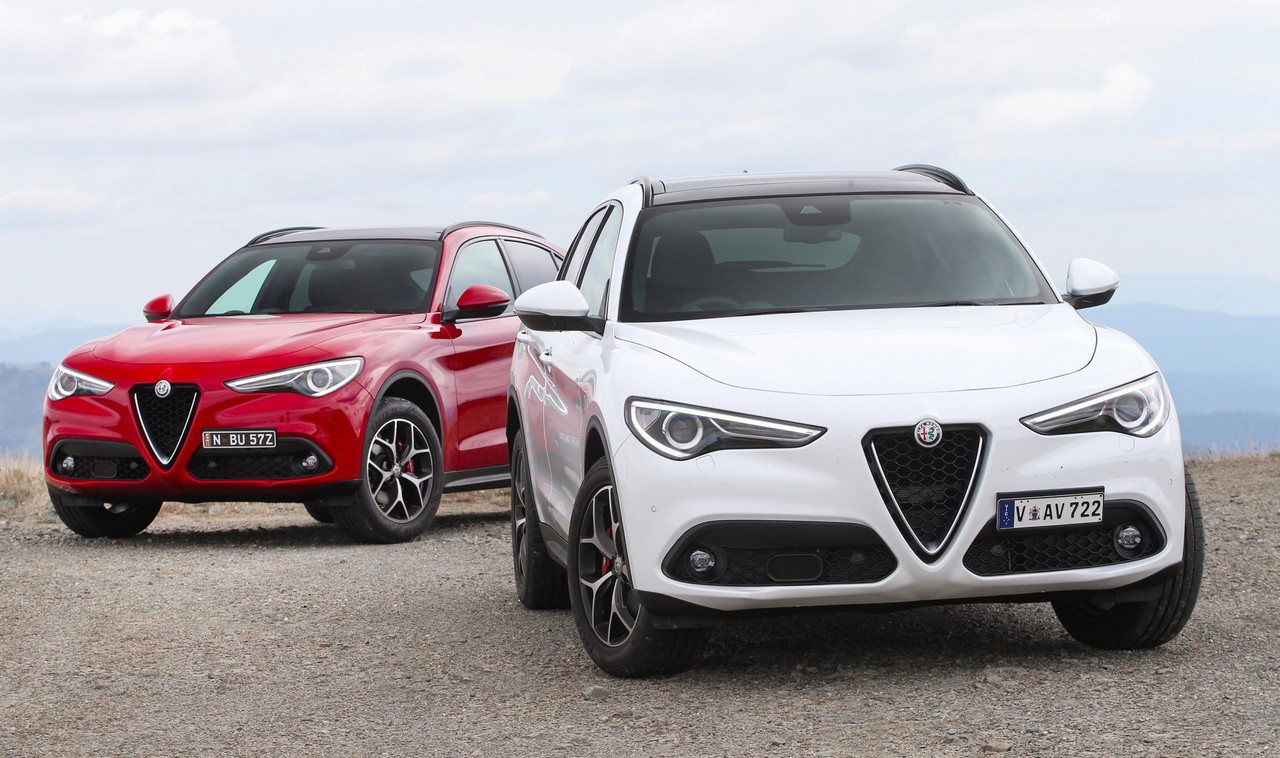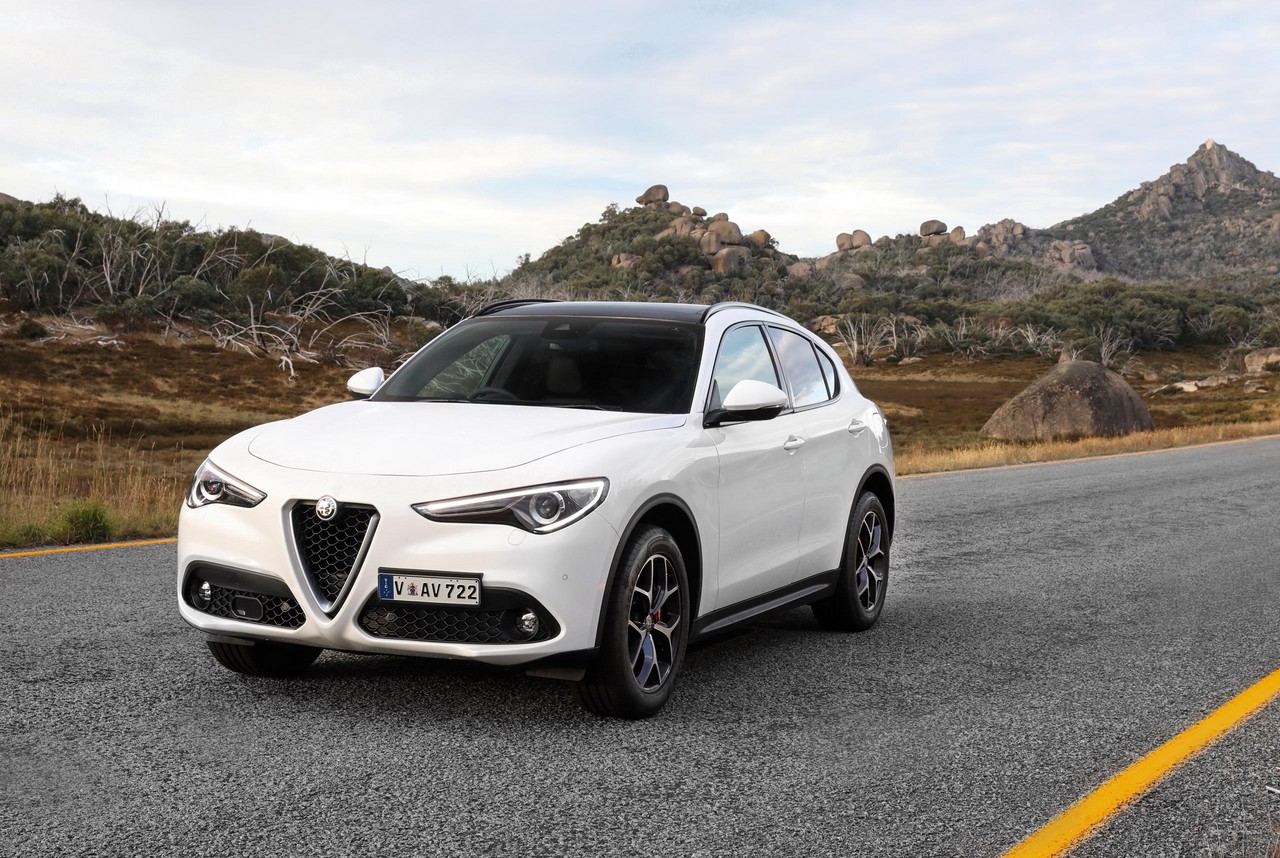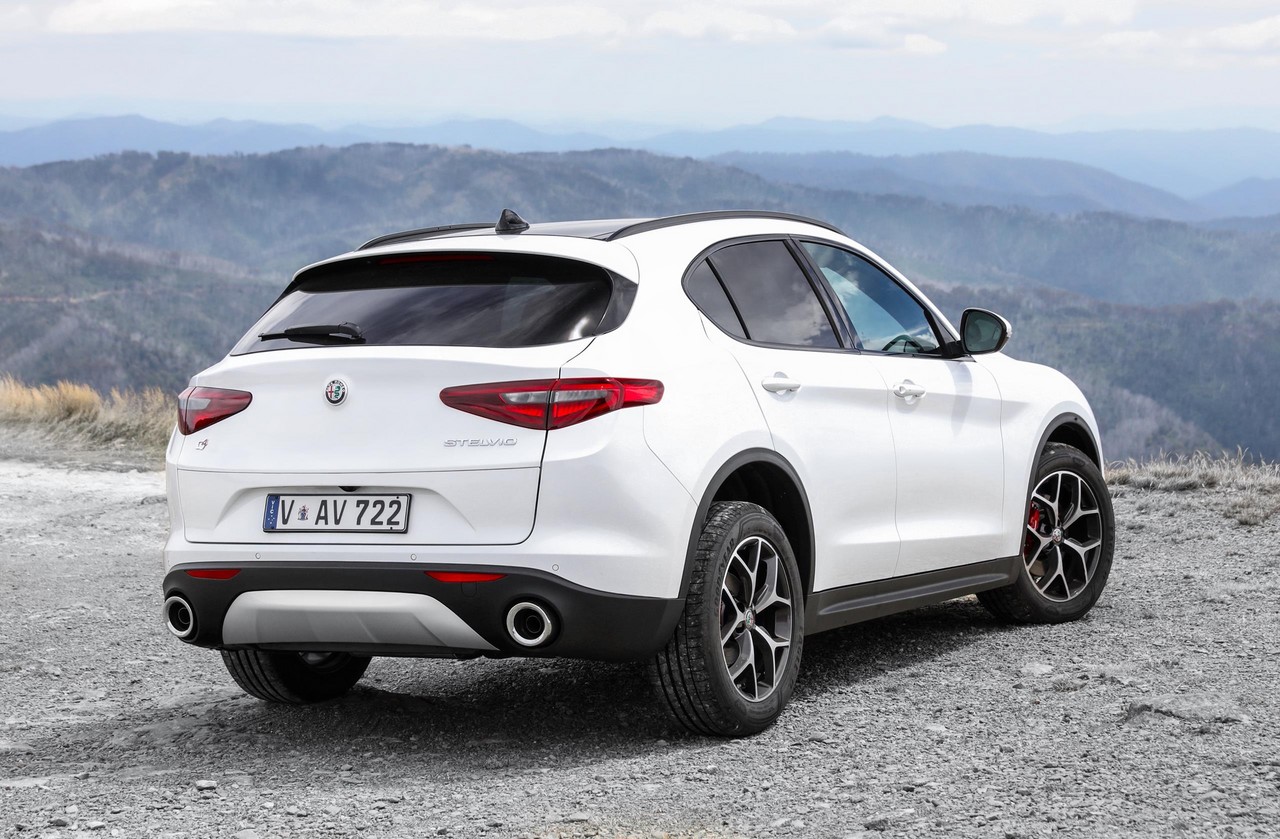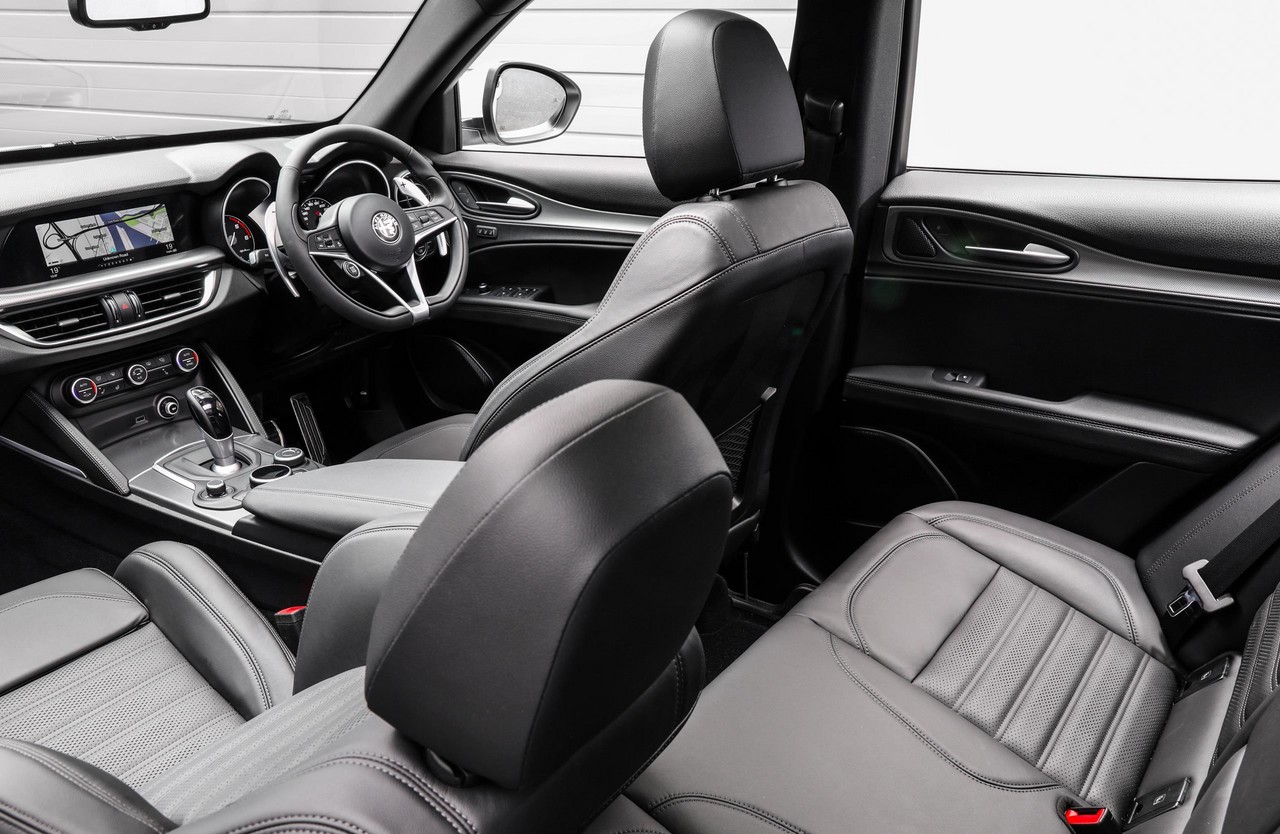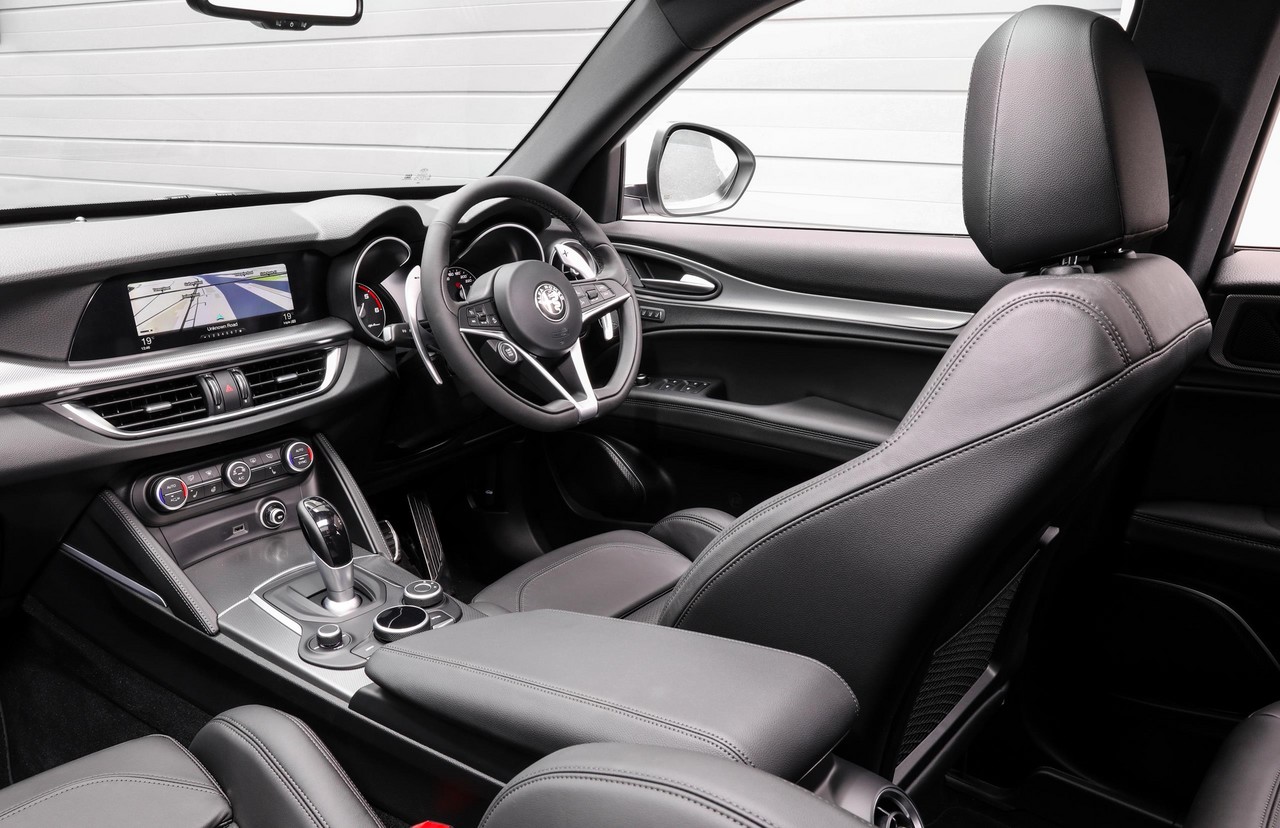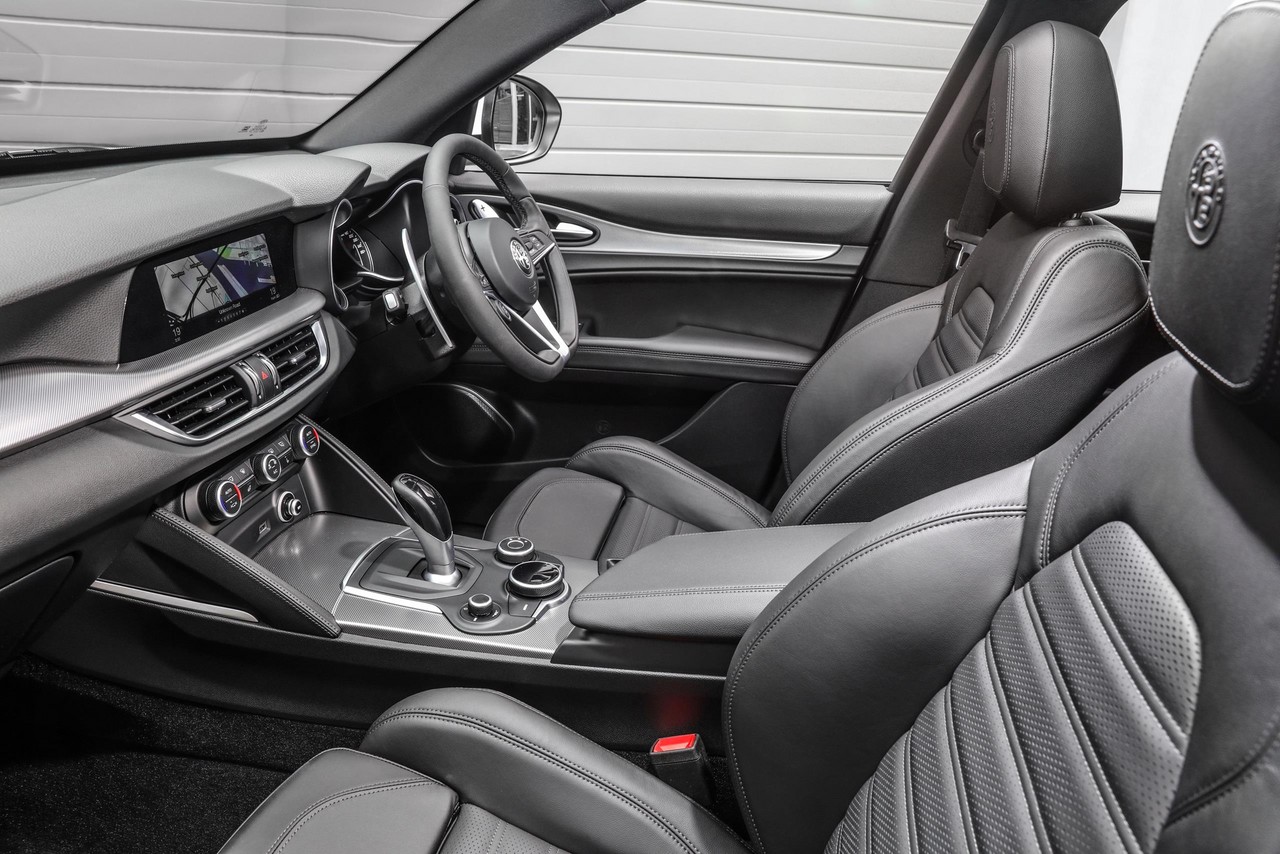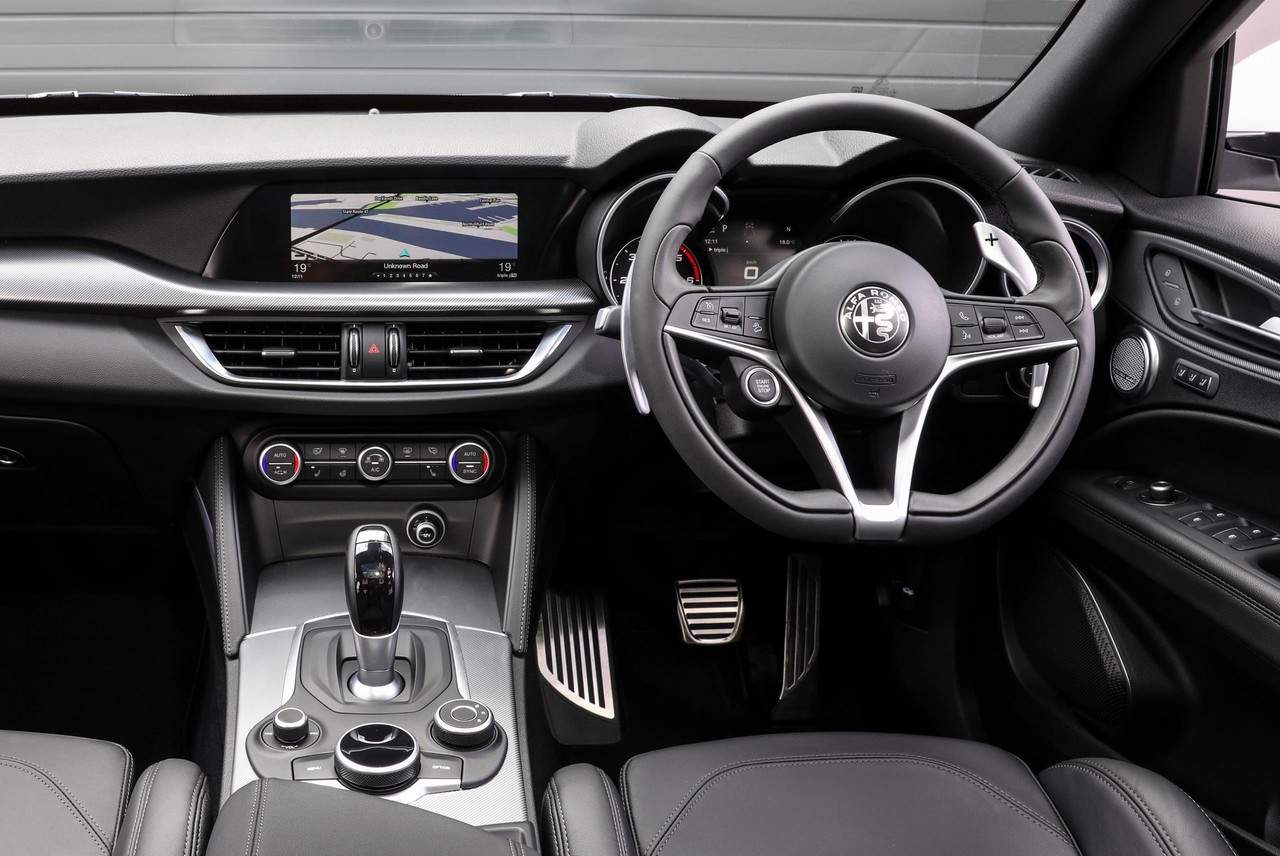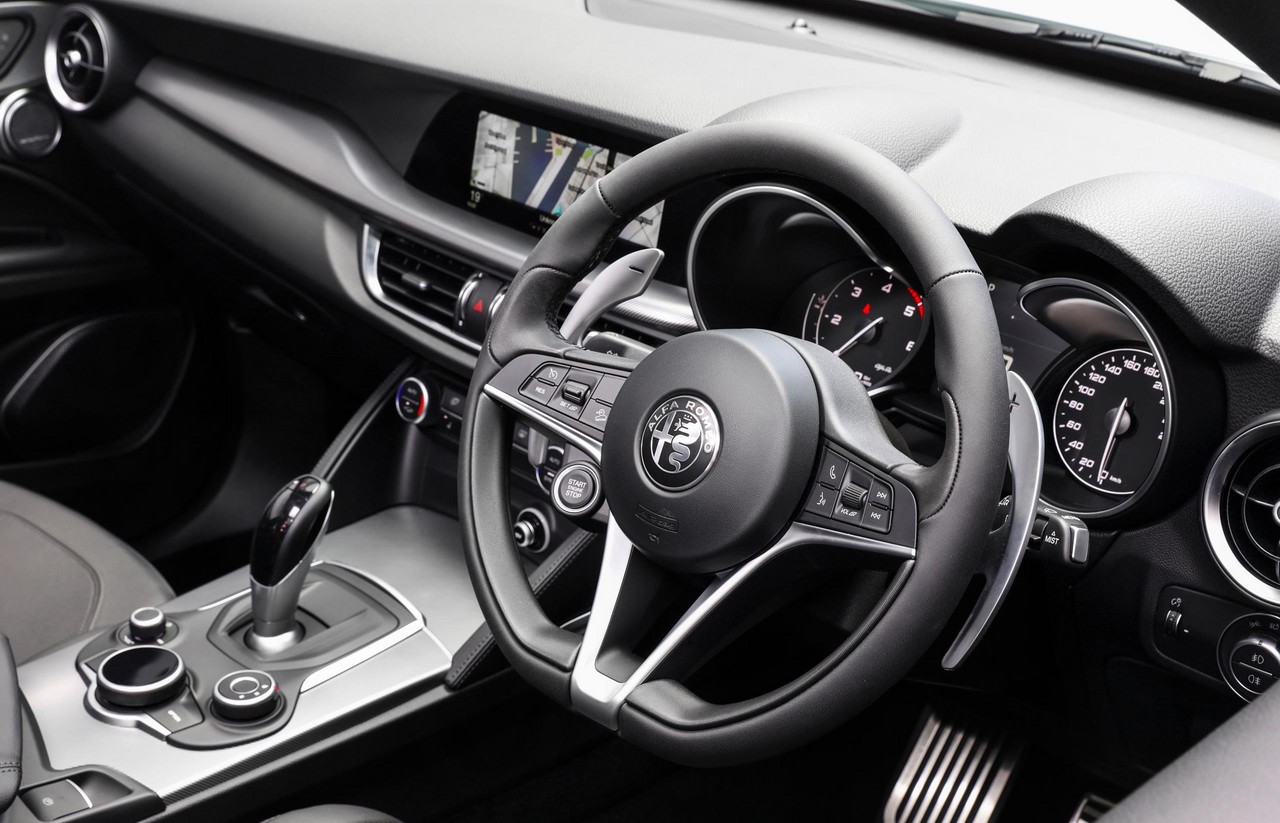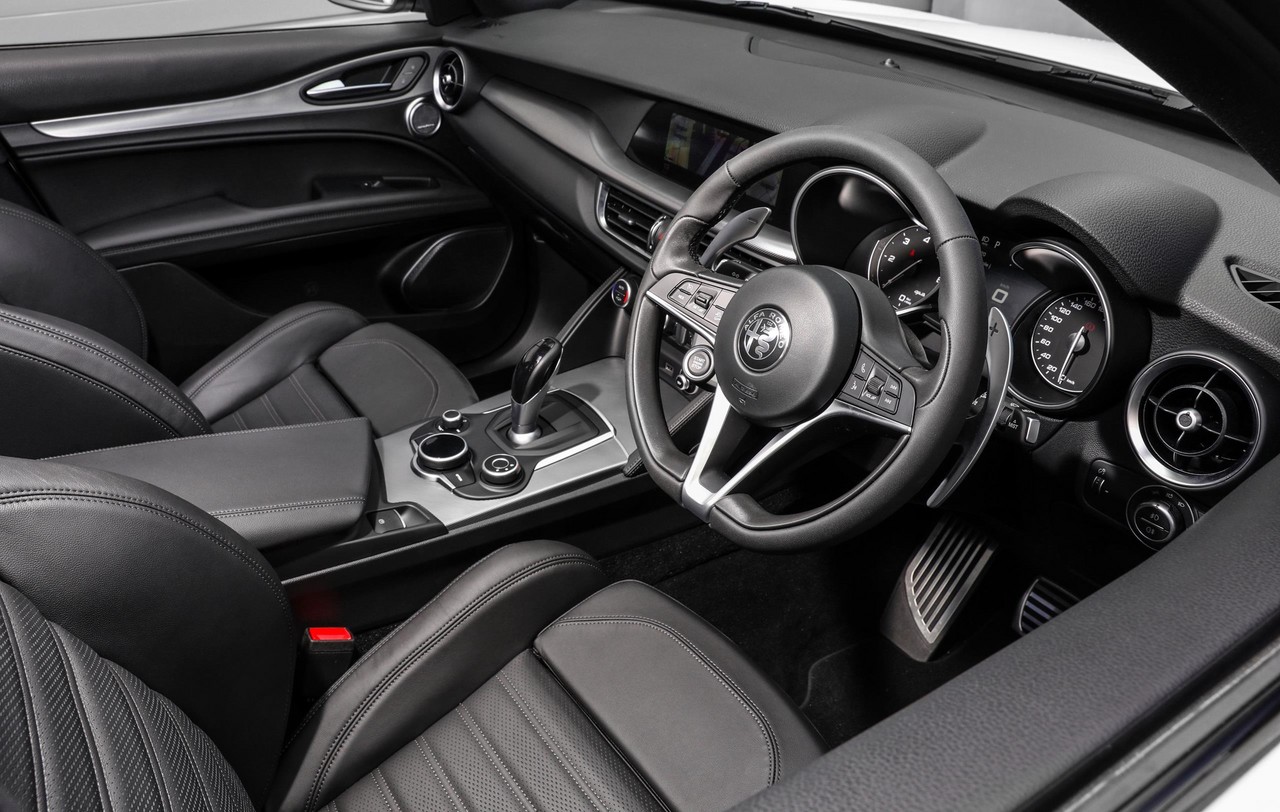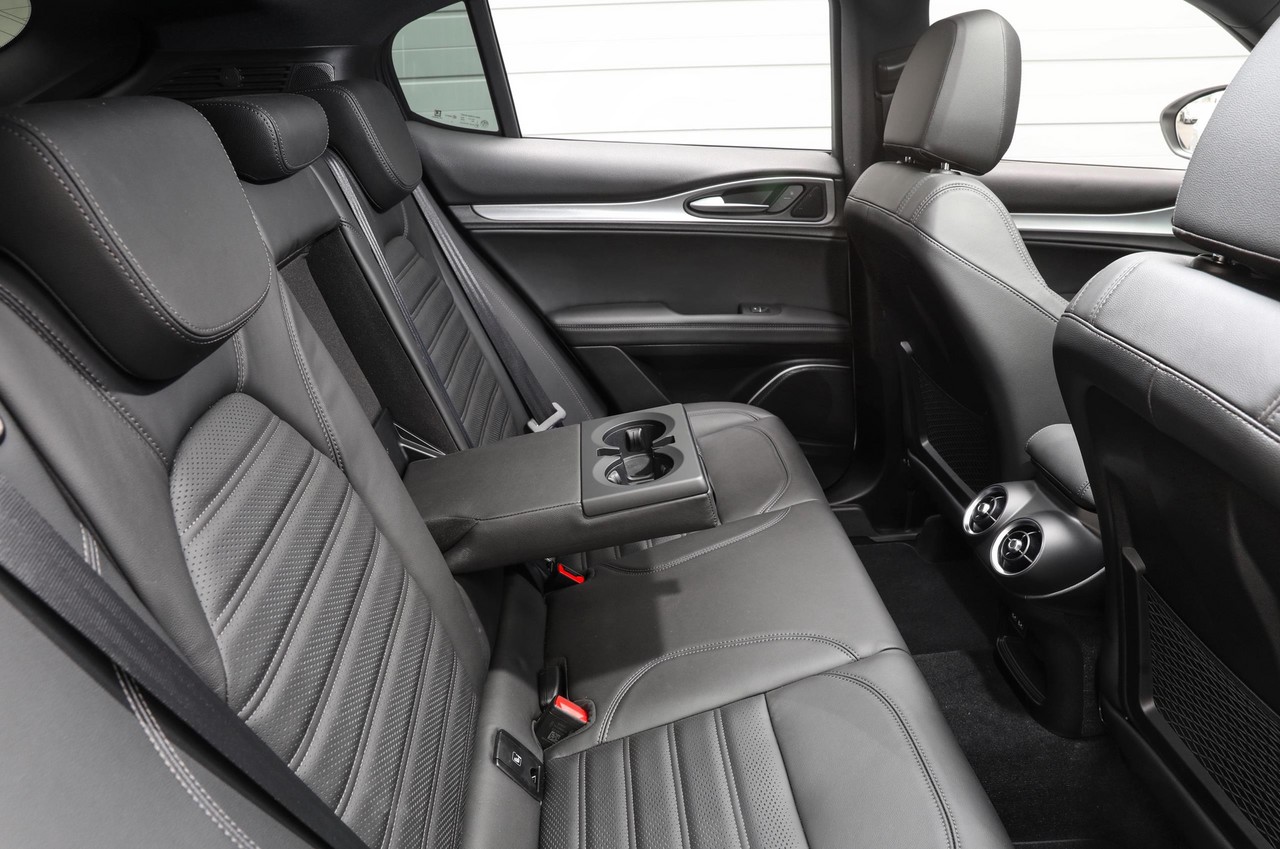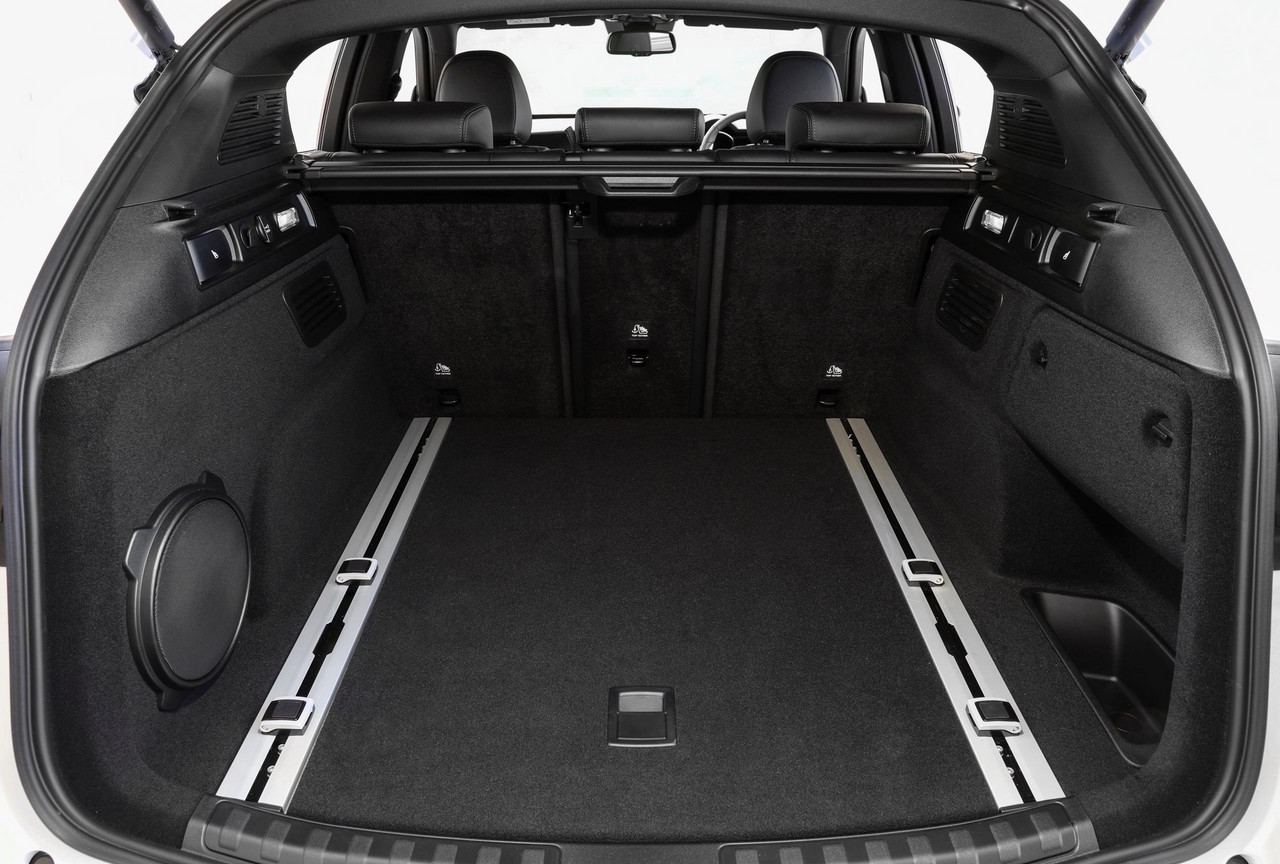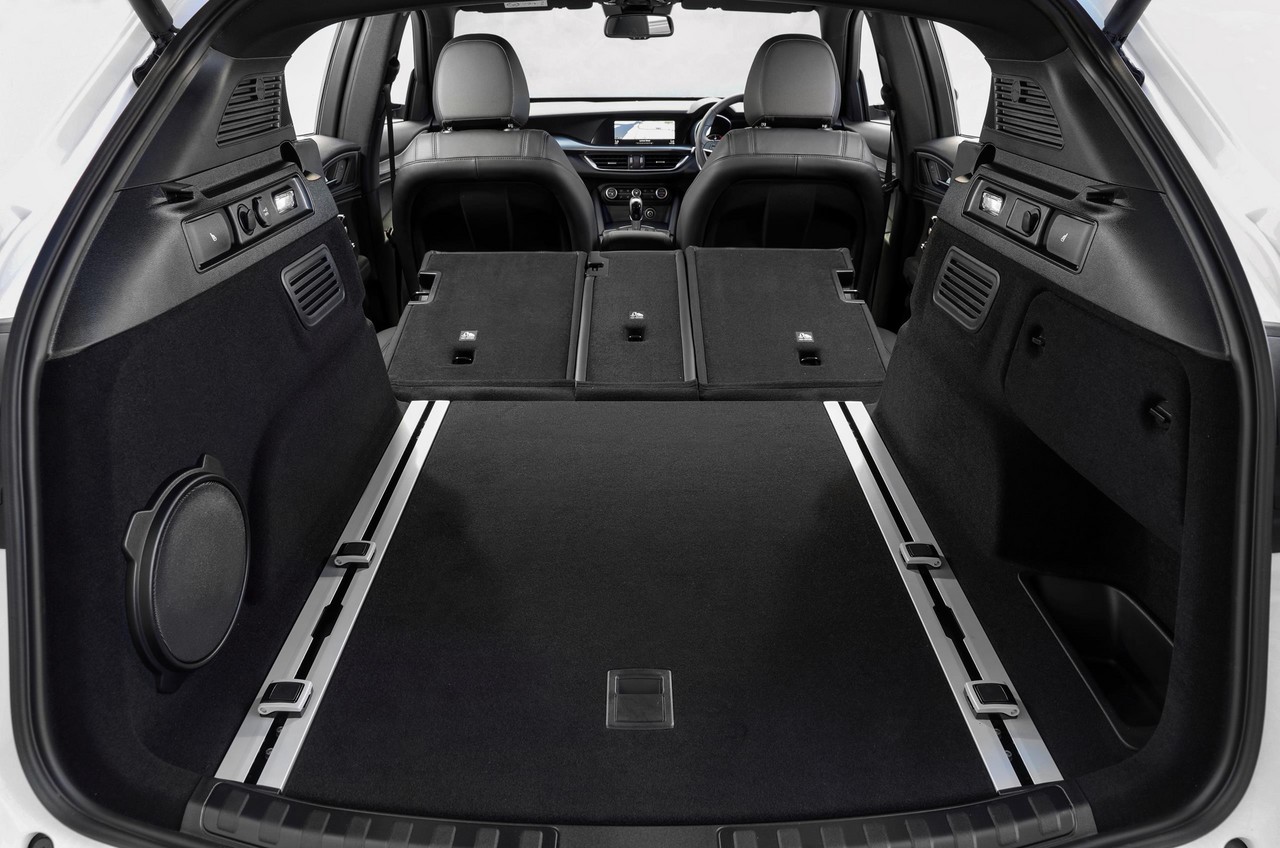
- Supportive front seats have wide range of adjustment
- Responsive diesel engine
- Refined eight-speed ZF automatic transmission
- Impressive dynamic ability and body control…
- … though the ride is easily unsettled
- Steering is overly assisted and lacks feel
- Poor rear seat headroom
- Hard interior plastics for doors and play in switchgear
Overview
Released in Australia in March 2018, the Alfa Romeo Stelvio was a mid-size SUV. Manufactured at Alfa Romeo’s Cassino plant in Frosinone, Italy, the all-wheel drive Alfa Romeo Stelvio was initially offered with 2.0-litre turbocharged petrol and 2.1-litre turbocharged diesel engines that were mated to eight-speed ZF automatic transmissions.
In May 2018, the range was expanded with the release of the Stelvio Ti – it was powered by a higher-output version of the 2.0-litre turbocharged petrol engine (see table below).
Alfa Romeo Stelvio Quadrifoglio
Australian deliveries of the Alfa Romeo Stelvio Quadrifoglio commenced in January 2019. The Stelvio Quadrifoglio was powered by a 2.9-litre biturbo V6 petrol engine – mated to an eight-speed automatic transmission – that enabled it to accelerate from rest to 100 km/h in 3.8 seconds. Upon its release, the Stelvio Quadrifoglio had a recommended retail price of $149,900 (excluded on-road costs).
| Variant | Engine | Trans. | Peak power | Peak torque | |
|---|---|---|---|---|---|
| Stelvio | 2.2 JTDM-2 | 2143 cc turbo diesel I4 | 8sp auto | 154 kW at 3750 rpm | 470 Nm at 1750 rpm |
| 2.0 MultiAir | 1995 cc turbo petrol I4 | 8sp auto | 147 kW at 5000 rpm | 330 Nm at 1750 rpm | |
| Stelvio Ti | 2.0 MultiAir | 1995 cc turbo petrol I4 | 8sp auto | 206 kW at 5250 rpm | 400 Nm at 2250-4500 rpm |
| Stelvio Quad-rifoglio | 2.9 Biturbo V6 | 2891 cc F154 biturbo petrol V6 | 8sp auto | 375 kW at 6500 rpm | 600 Nm at 2500-5000 rpm |
Q4 all-wheel drive system
All Alfa Romeo Stelvio vehicles were equipped with a ‘Q4’ all-wheel drive system. By default, the Q4 all-wheel drive system directed 100 per cent of the engine’s torque to the rear wheels. However, the system included an active transfer case that could engage a clutch to transfer up to 50 per cent of the engine’s torque to the front axle based on inputs from sensors measuring lateral and longitudinal acceleration, steering wheel angle and yaw.
The Alfa Romeo Stelvio also had a ‘Torque Vectoring’ function whereby two clutches in the rear differential could control torque delivery to each of the rear wheels to generate yaw.
Body and dimensions
The Alfa Romeo Stelvio shared its ‘Giorgio’ platform with the Alfa Romeo Giulia . Compared to the Alfa Romeo Giulia, the Stelvio was 44 mm longer (at 4687 mm), 43 mm wider (1903 mm), 212 mm taller (1648 mm) and had a 2 mm shorter wheelbase (2818 mm). The Alfa Romeo Stelvio had a cargo volume of 525 litres with the rear seats in position, though this increased to 1600 litres when the rear seats were folded down and luggage was filled to the roofline.
To reduce mass, the Alfa Romeo Stelvio used:
- Aluminium for the front and rear frames, front shock towers, brakes, suspension components, doors and bumpers;
- Aluminium and composite materials for the rear cross member; and,
- For models with petrol engines, the driveshaft was made from carbon fibre.
Kerb weights for the Alfa Romeo Stelvio ranged from 1604 kg (petrol) to 1660 kg (diesel).
Suspension
The Alfa Romeo Stelvio had double wishbone front suspension with a ‘semi-virtual steering axis’ and ‘Alfa Link’ rear suspension which had four-and-a-half links. Beyond this, the Stelvio Ti was equipped with Frequency Selective Dampers (FSD) that were supplied by Koni. With FSDs, a frequency selective valve that was incorporated into the damper unit could adjust the level of damping.
As an extra-cost option, the Alfa Romeo Stelvio Ti could be equipped with the ‘Alfa Active Suspension’ (AAS), a semi-active system which used a solenoid valve to modify hydraulic flows within the shock absorber to change its viscous damping co-efficient. The solenoids were wired to a control unit which sent commands depending on the control algorithm.
Steering
The Alfa Romeo Stelvio had rack-and-pinion steering with electric power assistance; the steering had a ratio of 12.0:1, while the Stelvio had a minimum turning circle of 11.7 metres.
Safety equipment
Standard safety equipment for the Alfa Romeo Stelvio included dual front airbags, front seat-mounted side airbags, full-length curtain airbags, ABS, electronic brake force distribution, brake assist, electronic stability control, traction control and front seatbelts with pre-tensioners and load limiters.
As standard, the Alfa Romeo Stelvio was fitted with the following active safety technologies:
- Forward Collision Warning (FCW) with Autonomous Emergency Brake (AEB): used radar sensors and a camera to monitor the road ahead for potential collisions. If detected, the driver was initially warned via an acoustic alarm. If the driver failed to react, the brakes were applied autonomously. For initial speeds of up to 60 km/h, collisions could be avoided while, at higher speeds, the severity of the collision was reduced;
- Integrated Brake System (IBS): an electromechanical braking system which combined the stability control system and a traditional servo to improve brake responsiveness and reduce stopping distances;
- Lane Departure Warning (LDW): used a camera to measure lane boundaries and compared them to the vehicle position. If the Stelvio departed from its lane without the indicator having been activated, a warning tone would sound; and,
- Blind Spot Monitoring (BSM): active at speeds above 10 km/h and when reversing, BSM used two radar sensors in the rear bumper to monitor traffic approaching from behind and in the driver’s blind spot. If a vehicle was present and the driver indicated to change lanes, a warning tone would sound. The BSM system also included a rear cross path detection system whereby approaching traffic could be detected from up to 14 metres away when the Stelvio was reversing.
Euro NCAP testing
In Euro NCAP testing , the Alfa Romeo Stelvio received a five star safety rating which included a 97 per cent adult occupant protection rating and an 84 per cent child occupant protection rating. In the frontal offset test, protection of the front occupants was rated as good in all body areas except for the driver’s lower right leg which was rated adequate (i.e. a slight risk of serious injury). In the side impact and pole tests, however, maximum points were awarded.
Features: Alfa Romeo Stelvio
Standard features for the Alfa Romeo Stelvio included 19-inch x 8.0J ten-spoke alloy wheels with 235/55 R19 tyres, a ‘UConnect’ infotainment system with an 8.8-inch display and satellite navigation, an eight speaker sound system, digital radio tuner (DAB), Bluetooth mobile phone connectivity and audio streaming, full-grain leather seats, power adjustable front seats, dual-zone climate control air conditioning, cruise control, bi-xenon headlights, dusk-sensing headlights, rain-sensing wipers, a rear view camera with dynamic guidelines, rear parking sensors, a leather-wrapped steering wheel, steering column-mounted gearshift paddles, remote central locking, power adjustable and heated door mirrors, power windows, a height and reach adjustable steering column, an auto-dimming rear-view mirror, push-button start, a power-operated tailgate, seven-inch colour instrument cluster, tyre pressure monitoring and an immobiliser.
Alfa Romeo’s ‘DNA Drive Mode Selector’ enabled the driver to select from the following settings:
- Dynamic: increased steering weight, greater accelerator and brake pedal response, more aggressive transmission calibration;
- Natural: a ‘comfort’ setting for ‘balanced daily driving; and,
- Advanced Efficiency: reduced accelerator pedal response, earlier upshifts and reduced air conditioning output to enhance fuel efficiency.
Features: Alfa Romeo Stelvio Ti
Compared to the standard Alfa Romeo Stelvio, the Stelvio Ti was further equipped with 20-inch x 8.5J alloy wheels with 255/45 R20 tyres, a 10 speaker sound system that had an output of 400 watts, Adaptive Cruise Control (ACC), front sports seats with heating, a heated steering wheel, rear privacy glass and aluminium pedals. Visually, the Stelvio Ti could be identified by its red brake callipers.
As standard, the Alfa Romeo Stelvio Ti was equipped with a mechanical rear limited slip differential (LSD).
Veloce Option Pack
As a $5000 extra-cost option, the Alfa Romeo Stelvio could be specified with a Veloce Option Pack which included 19-inch ‘sport’ alloy wheels, front sports seats with power adjustable bolters, heated front seats, a sport steering wheel with heating, aluminium interior trim, aluminium sports pedals, Koni frequency selective dampers, black-painted roof rails and red-painted brake callipers.
Alfa Romeo Stelvio First Edition
Released in Australia in March 2018, the Alfa Romeo Stelvio First Edition had a $6000 price premium to the standard Stelvio variants and was equipped with the following items: 19-inch ‘exclusive sport’ alloy wheels, a 900 watt harman kardon audio system with fourteen speakers, sports fronts seats with power adjustable bolsters, heated front seats, a sport steering wheel with heating, a panoramic sunroof, aluminium interior trim, aluminium pedals, rear privacy glass, Koni frequency selective dampers, black-painted roof rails and red-painted brake callipers. According to Alfa Romeo, these items were worth over $8000.
Brochure
